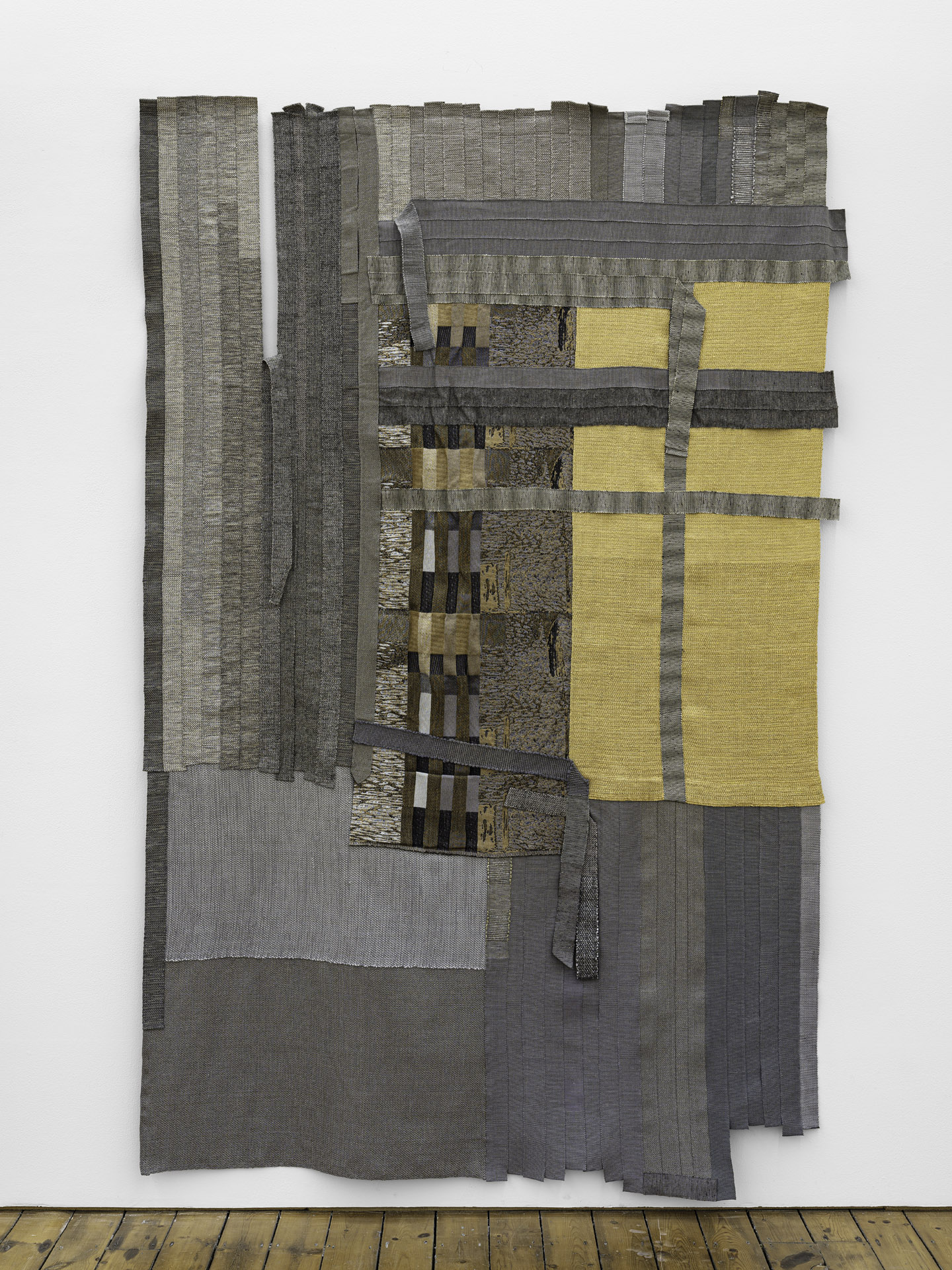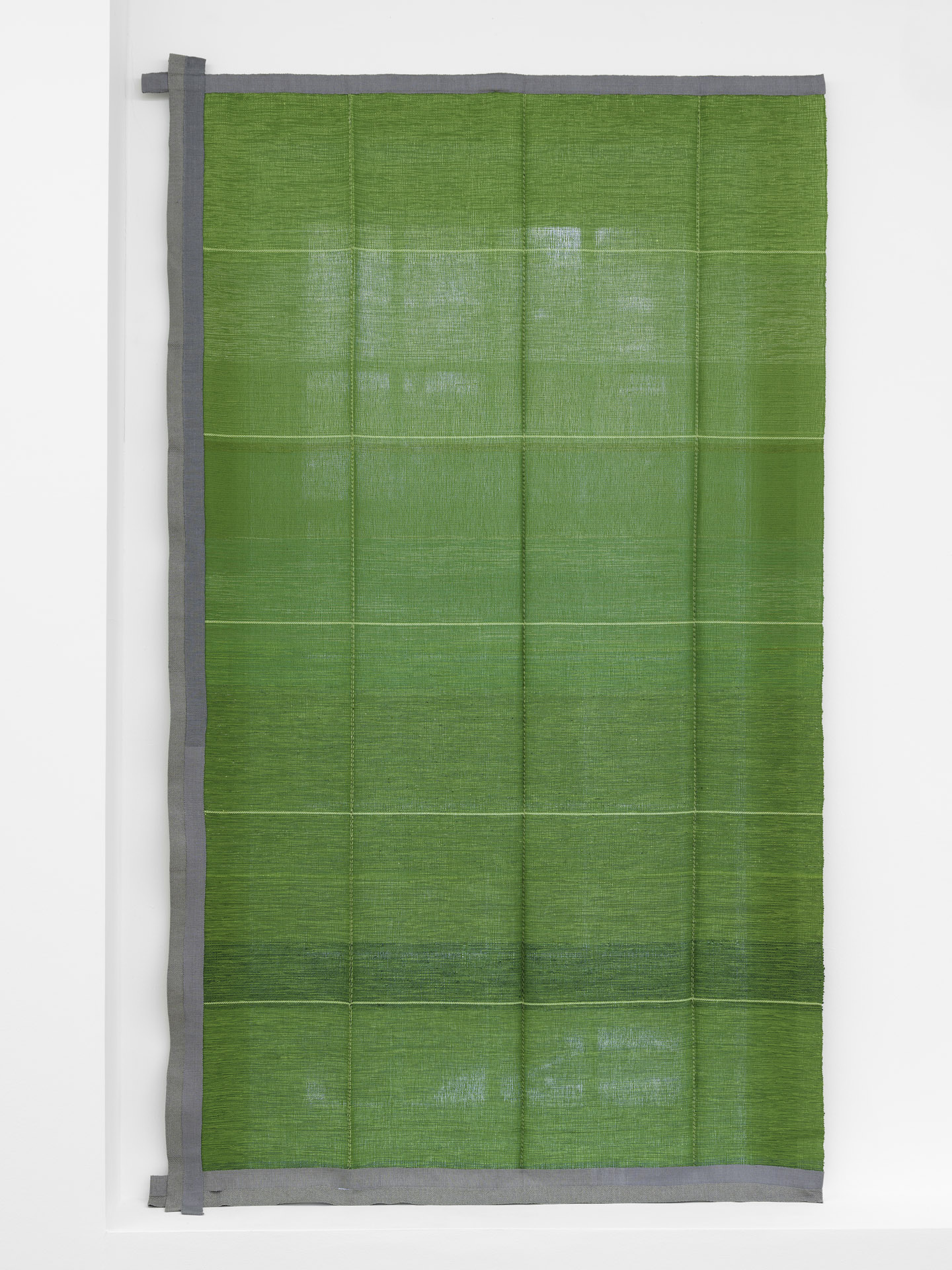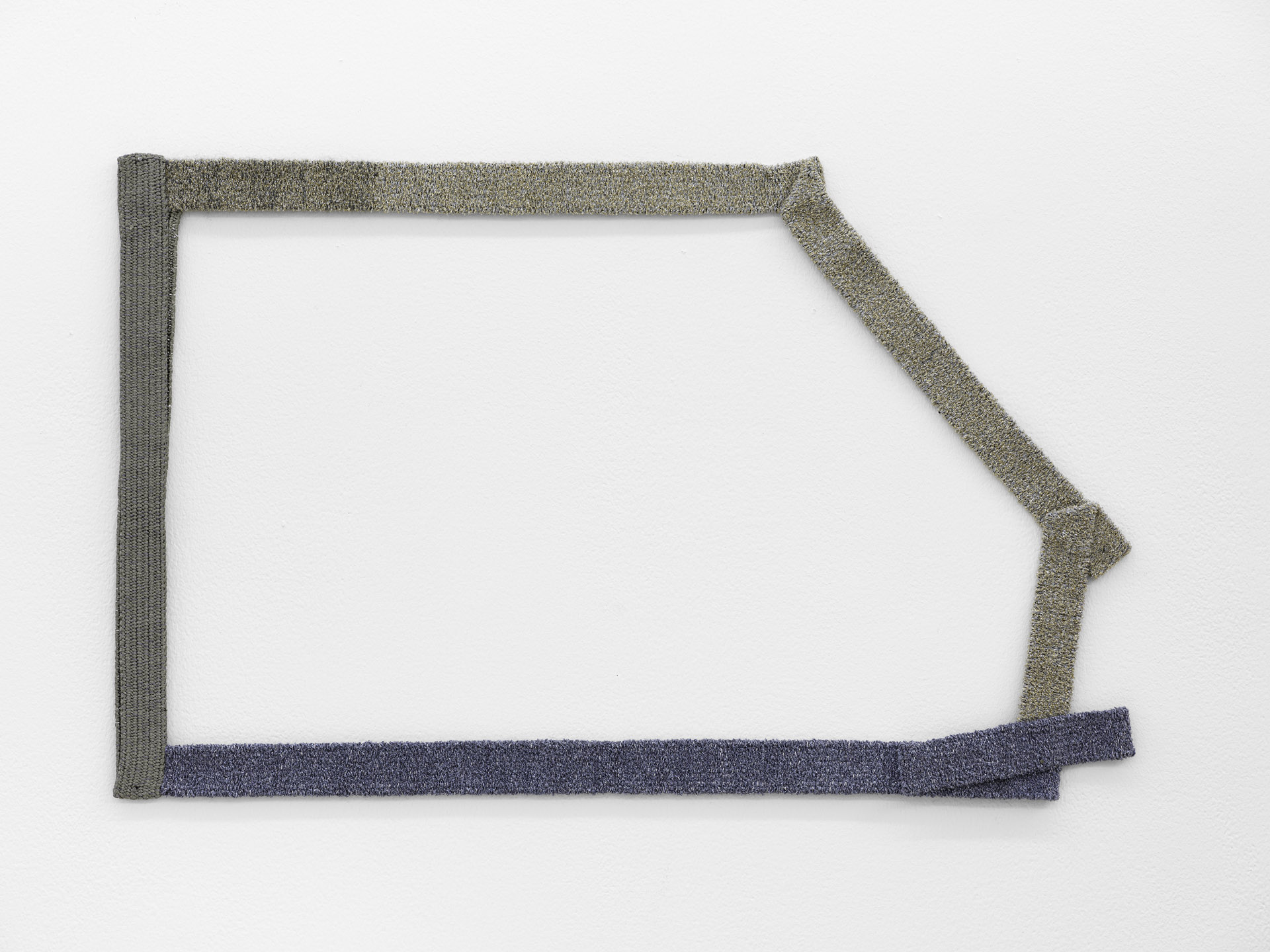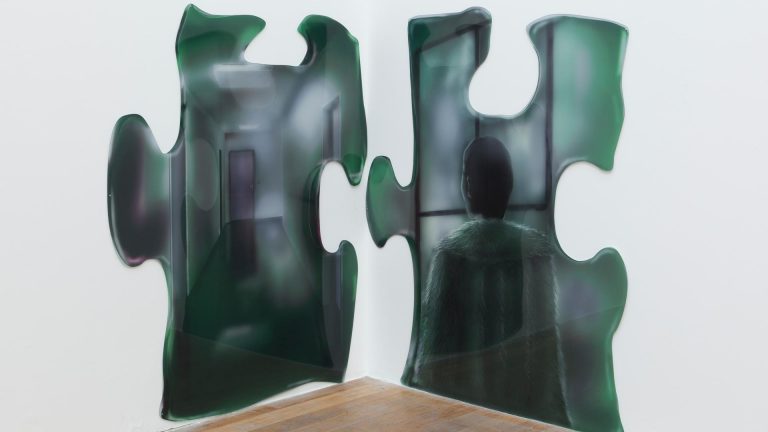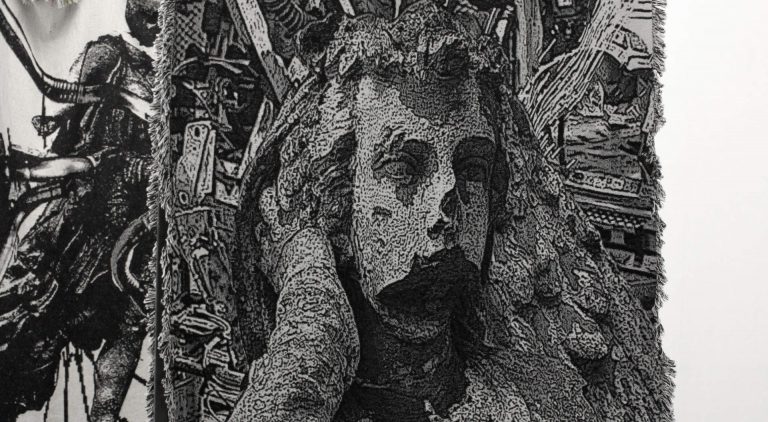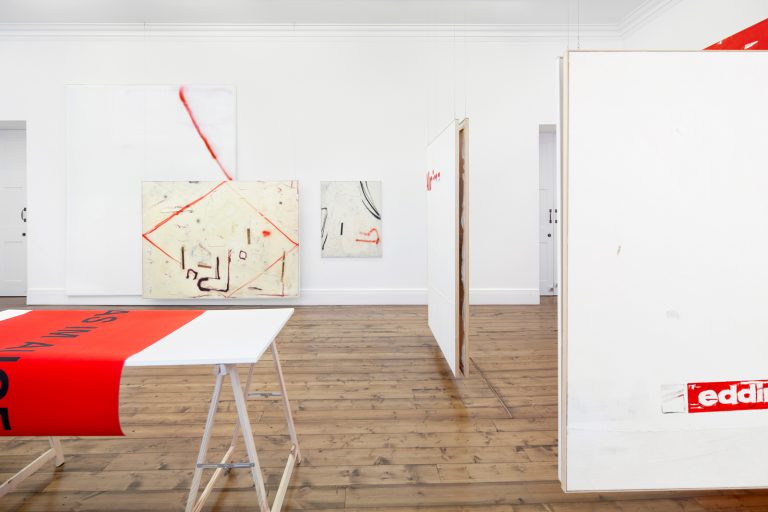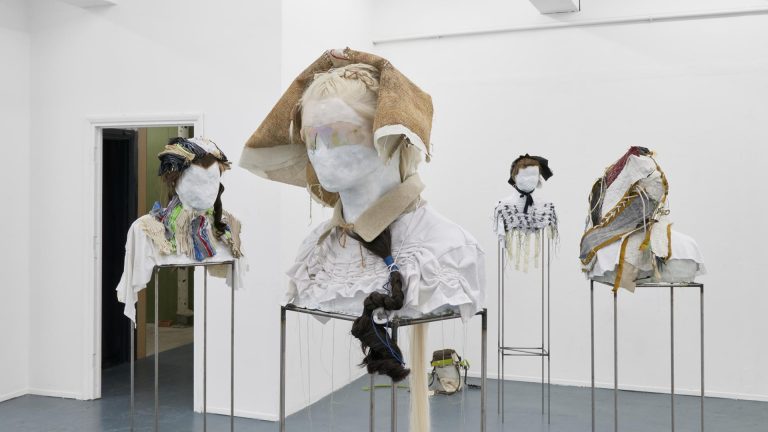Artist: Hana Miletić
Exhibition title: Patterns of Thrift
Venue: The Approach, London, UK
Date: May 8 – June 19, 2021
Photography: all images copyright and courtesy of the artist and The Approach, London
There is a micro-political dimension to weaving for Hana Miletić, who employs this process as a method of slowing down production. She sees it as an embodied and situated art practice that requires considerable time and dedication, aimed at counteracting certain economic and social conditions at work, such as acceleration, standardisation and transparency. Miletić weaves to narrate a different, feminist story of technology and progress stemming from the loom (not extractive and technocratic, but caring and tactile). She sees care as an affect – because caring produces emotional attachments, a real material action that disrupts the artificial and brutal seizure between head and hand, between thinking and feeling – and as an ethical obligation, because caring and repairing are forms of knowledge, building blocks for politics that serve us better.
For ‘Patterns of Thrift’, her debut exhibition at The Approach, Miletić will produce new works from her ongoing series ‘Materials’. Though at first seemingly abstract, these textile works find their scale, form and colour, as well as their positioning in the exhibition space, from the acts of ‘care and repair’ that Miletić has noticed around the city. Broken windows, kicked in doorways and damaged car wing mirrors are haphazardly taped up with plastic and card, poetically transformed by small considerate gestures. Initially photographed by the artist, she then emulates these DIY repairs through a process of hand-weaving textiles – thereby furthering the act of care. Working on a 1:1 ratio, shifts in scale fluctuate between the very small (perhaps seen in the repair of a doorbell) and the very large (as with the repairs of entire shop windows or doors), demonstrating that regardless of size, all acts of care matter.
The exhibition is partly inspired by the history of the gallery’s local Bethnal Green area, which, along with other parts of East London, developed as a site for silk weaving from around the mid-seventeenth century. The title in particular refers to the absorption of exiled Hugenots (protestants fleeing from the Catholic French king) into the East London weaving communities, whilst the works in the show will be produced as ‘half-silks’. Though the term has fallen into disuse since modern import and export laws require all material content to be declared, historically, a ‘half-silk’ refers to a fabric woven from silk with another material used as the warp textile. Like in nearby Spitalfields, the weavers in Bethnal Green were mostly producing half-silk ribbons and trims, sometimes including gold and silver thread. Using this concept as her departure point, all the works in this exhibition have been made using different silk fibres entangled with other organic materials such as hemp, raffia and wool, as well as artificial fibres including recycled nylons, plastics and gold and silver metal yarns (the latter referring to the half-silk ribbons typical of the area). Hinting at the slow erosion and eventual disappearance of the textile industry from East London driven by the success and efficiency of machines, Miletić has also included patches of automated woven fabric into the works, made with the use of a Jacquard loom (the forerunner of the present-day computer).
Increasingly incorporating recycled and upcycled fibres to produce her work, Miletić feels a growing awareness of the environmental and social factors surrounding textile production, manufacture and consumption. Although this repurposing of fabrics can sometimes compromise the accuracy of the replication of her ‘repairs’ (by creating more aesthetic or structural inconsistencies that resemble the source image less closely than earlier works might), Miletić feels this is preferable if it helps her work in a more ethical, responsible and sustainable way. This includes ensuring the ethical treatment of all species of workers involved, for example, since all of the works in this show contain silk fibres,
Miletić has avoided using newly spun silks where silkworms have died to produce the silk. Instead, she prefers to use peace or eri silk produced from non-violent breeding and harvesting of silkworms, which allows the animals to complete their metamorphosis into moths.
Her merging of different materials, natural and artificial, also helps the artist to explore ideas surrounding capitalist production and desire, complicating claims that the existence of nature is a separate category from culture. Influenced by speculative feminist writing, Miletić acknowledges the non-innocence in which she lives and works, and understands the interconnectedness of all species with one another. Through its reproduction of repairs and patchy assemblages, this exhibition demonstrates the complicated entanglements formed by and between everything and everyone, non-human, human and more-than-human – silk worms, silk weavers, Jacquard looms, and computers included.
Hana Miletić (b.1982, Zagreb, Croatia), lives and works in Brussels. Recent solo exhibitions include Bergen Kunsthall, Bergen, Norway (forthcoming 2021); La Loge, Brussels, Belgium (2021); Lambda Lambda Lambda, Prishtina, Kosovo; La Maison de Rendez-Vous, Brussels, Belgium; Apoteka Space for Contemporary Art, Vodjnan, Croatia; The Annexe, London, UK (all 2019); WIELS Contemporary Art Centre, Brussels, Belgium (2018); and participation in the 13th Sharjah Biennial (2017). Group exhibitions include KAI 10 | Arthena Foundation, Dusseldorf, Germany and 39th EVA International, Ireland Biennial of Contemporary Art; Art Encounters Biennial, Timișoara, Romania (forthcoming 2021); Muzeum Sztuki, Łódź, Poland; Kunsthalle Wien, Vienna, Austria (both 2020); Metro Pictures, New York (2019); S.M.A.K., Ghent, Belgium and TextielMuseum, Tilburg, Netherland (both 2018-19).
Past residencies include: The Cultural Centre of the Josef and Anni Albers Foundation in Senegal (2019), and the Jan van Eyck Academy in Maastricht (2014-2015). In the last few years, Miletić has facilitated collaborative projects at Globe Aroma, Brussels and De Appel, Amsterdam.
Hana Miletić, Patterns of Thrift, 2021, exhibition view, The Approach, London, photo: Eva Herzog
Hana Miletić, Patterns of Thrift, 2021, exhibition view, The Approach, London, photo: Eva Herzog
Hana Miletić, Patterns of Thrift, 2021, exhibition view, The Approach, London, photo: Eva Herzog
Hana Miletić, Patterns of Thrift, 2021, exhibition view, The Approach, London, photo: Eva Herzog
Hana Miletić, Patterns of Thrift, 2021, exhibition view, The Approach, London, photo: Eva Herzog
Hana Miletić, Patterns of Thrift, 2021, exhibition view, The Approach, London, photo: Eva Herzog
Hana Miletić, Patterns of Thrift, 2021, exhibition view, The Approach, London, photo: Eva Herzog
Hana Miletic, Materials, 2020-21, Hand-woven and Jacquard-woven textile (polar white silk raphia, shell white organic flax, soft white eri silk, white polyester, and white recycled silk laps), 115 x 77 x 5 cm (45 1/4 x 30 1/4 x 2 in.), photo: Eva Herzog
Hana Miletic, Materials, 2021, Hand-woven and Jacquard-woven textile (burnt orange recycled wood fibre, carrot and dahliacoloured eri silk, dark apricot recycled polyamide, recycled nylon, recycled plastic thread, and white polyester), 30 x 24 x 2 cm (11 3/4 x 9 3/8 x 3/4 in.), photo: Eva Herzog
Hana Miletic, Materials, 2020, Hand-woven and Jacquard-woven textile (grey eri silk, recycled nylon, recycled plastic thread, shell white organic flax, white polyester, and white recycled silk laps), 32 x 23 x 5 cm (12 1/2 x 9 x 2 in.), photo: Eva Herzog
Hana Miletic, Materials, 2021, Hand-woven textile (carmine mercerised cotton, gold yellow recycled silk laps, recycled nylon, red metal yarn, red organic cottolin, scarlet organic cotton, and spectrum red hand-twined recycled polyester), 41 x 66 x 1 cm (16 1/8 x 26 x 3/8 in.), photo: Eva Herzog
Hana Miletic, Materials, 2021, Hand-woven textile (apple green organic cotton, basil green organic linen, dark green flax cord, dark green recycled plastic raphia, dark silver upcycled polyamide, emerald green eri silk, fern green organic linen, moss green organic silk, neutral grey hand-spun organic cotton, pickle green flax, pine green silk noil, platinum mercerised cotton, seaweed green eri silk, and silver metal yarn), 156 x 260 x 1 cm (61 3/8 x 102 1/4 x 3/8 in.), photo: Eva Herzog
Hana Miletic, Materials, 2020, Hand-woven textile (gold eri silk, gold metal yarn, and organic hemp), 22 x 20 x 4 cm (8 5/8 x 7 3/4 x 1 1/2 in.), photo: Eva Herzog
Hana Miletic, Materials, 2020, Hand-woven textile (copper metal yarn, gold eri silk, gold metal yarn, gold-painted recycled wood fibre, old gold metal yarn, organic hemp, pale gold recycled polyamide, and variegated gold organic cotton cord), 101 x 147 x 2.5 cm (39 3/4 x 57 3/4 x 1 in.), photo: Eva Herzog
Hana Miletic, Materials, 2021, Hand-woven and Jacquard-woven textile (black eri silk, dark silver recycled polyamide, gold eri silk, gold metal yarn, gold upcycled silk ribbon, neutral grey hand spun organic wool, old gold metal yarn, organic hemp, pale gold upcycled polyamide, platinum mercerised cotton, rust black mercerised cotton, silver metal yarn, silver-painted recycled wood fibre, soft white eri silk, and white polyester), 250 x 150 x 3 cm (98 3/8 x 59 x 1 1/8 in.), photo: Eva Herzog
Hana Miletic, Materials, 2020, Hand-woven textile (chestnut wool and silk, dark neutral grey hand-spun organic wool, dark silver recycled polyamide, silver metal yarn, silver waxed cord, and silver-painted recycled wood fibre), 44 x 65 x 1 cm (17 1/4 x 25 1/2 x 3/8 in.), photo: Eva Herzog
Hana Miletic, Materials, 2020, Hand-woven textile (ash grey textured metal yarn, chestnut wool and silk, dark neutral grey hand-spun organic wool, dark silver recycled polyamide, silver metal yarn, and white gold textured metal yarn), 56 x 71 x 2 cm (22 x 27 7/8 x 3/4 in.), photo: Eva Herzog
Hana Miletic, Materials, 2020, Hand-woven textile (black organic linen, copper metal yarn, gold eri silk, gold metal yarn, gold yellow recycled silk laps, and organic hemp), 13 x 19 x 2 cm (5 x 7 3/8 x 3/4 in.), photo: Eva Herzog
Hana Miletic, Materials, 2021, Hand-woven textile (gold eri silk, gold metal yarn, gold upcycled silk ribbon, old gold metal yarn, organic hemp, and pale gold recycled polyamide), 163 x 68 x 1 cm (64 1/8 x 26 3/4 x 3/8 in.), photo: Eva Herzog

